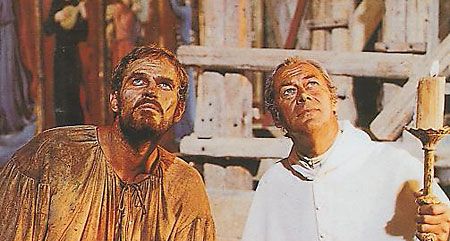Religion
Related: About this forumMichelangelo, religious tolerance and the 500th anniversary of the Sistine Chapel ceiling
Dec 05, 2012 11:05 PM EST
TheWashingtonPost
By Benjamin Blech

Michelangelo’s genius as perhaps the greatest of all artists of Western civilization is universally recognized. His frescoes on the ceiling of the Sistine Chapel are assuredly the major reason why the Vatican Museums in Rome welcome more than 4 million visitors annually, making the site the most-visited museum complex on earth.
What is far less known to Michelangelo’s countless admirers is the incredible courage of a man far ahead of his time, daring to introduce ideas considered heretical in his day into the holiest chapel in the Christian world, but ideas that have finally found a large measure of confirmation in our time. As we commemorate the 500th anniversary of the completion of his masterpiece this month, bringing Michelangelo’s convictions to light is long overdue.
Four and a half centuries before the Second Vatican Council rejected religious intolerance in the mid-1960s, before Pope John Paul II acknowledged Jews as Christianity’s “older brothers and sisters” and, in 2000, placed a prayer into the Western Wall in Jerusalem begging God to forgive the Catholic Church for its mistreatment of the Jews throughout the centuries, Michelangelo found ways to express his commitment to religious open-mindedness as well as to convey his profound horror at the abuse directed at the people who were nothing less than the ancestors of Jesus.
At the time that Michelangelo was toiling in the Sistine, the status of Jews in the Western world was at an all-time low. The Inquisition was churning at the height of its powers, having already despoiled and expelled the Jews from Spain, Portugal and Sicily. Jewish wisdom literature was being burned in public bonfires all over Europe, and sometimes the holy rabbis and sages who taught these texts were thrown to the flames as well. Jews and Christians were being driven apart by politics, prejudice and propaganda. The Jewish roots of Jesus and Christianity were being negated. In art, Jews were turned into diabolical caricatures, while Jesus, his family and his apostles were all visually “de-judaized.” In society, it became more and more difficult for Jews and Christians to be neighbors and friends; only three years after the Sistine ceiling frescoes were finished, the Jews of Venice were locked into the world’s first ghetto. Jews could not build or live where they wanted. Spreading the most ridiculous blood libels about Jews, assaulting Jews in public, accusing Jews of disloyalty to their host countries - all this became the norm. In short, Jews were considered as guilty of all of society’s ills in that era as they were of deicide in the distant past.
http://www.washingtonpost.com/blogs/guest-voices/post/michelangelo-religious-tolerance-and-the-500th-anniversary-of-the-sistine-chapel-ceiling/2012/12/05/d0074a3a-3f2b-11e2-bca3-aadc9b7e29c5_blog.html
muriel_volestrangler
(101,321 posts)CTyankee
(63,912 posts)Michelangelo. Couldn't they make the routine about Leonardo instead? After all, he really DID paint The Last Supper...![]()
cbayer
(146,218 posts)I had no idea. Thanks so much for this.
rug
(82,333 posts)
cbayer
(146,218 posts)that point in my life.
But i don't think I ever saw the movie.
Anyway, Michelangelo became and remained one of my heroes very early on and this just adds to my deep admiration.
Hestia
(3,818 posts)There is a special door that the pope uses and this is where Michelangelo painted that particular putti. They didn't know it was there until the ceiling was cleaned. Lots of other surprises too.
Excellent book, well, maybe not excellent but an interesting read with pictures of what the authors are referencing:
The Sistine Secrets: Michelangelo's Forbidden Messages in the Heart of the Vatican
cbayer
(146,218 posts)I think I would like that book very much!
Granny M
(1,395 posts)Too wonderful!
elleng
(130,974 posts)
okasha
(11,573 posts)on someone who didn't know how to portray women. His ladies are essentially "men with boobs," even those with such delicately rendered faces as Mary's in the Pieta.
That said, it's remarkable that Michelangelo worked such subversive elements into his art right under the noses of ecclesiastical patrons.
muriel_volestrangler
(101,321 posts)(Sir Anthony Blunt, an art historian who looks after the Queen's pictures, and a former Soviet spy, is being gently interrogated by Chubb, an MI5 officer):
"Do we say Giotto isn't a patch on Michelangelo because his figures are less lifelike?"
"Michelangelo?" says Chubb, "I don't think his figures are more lifelike, frankly. The women aren't. They're just like men with tits. And the tits look as if they've been put on with an ice-cream scoop. Has nobody pointed that out?"
"Not in quite those terms."
And I suppose that is what I feel about Michelangelo's women, though don't like to say so. Husky, I suppose, is the word for them - steroidal almost. I don't think she'd be allowed in the 100m dash without giving at least one urine sample.
http://www.independent.co.uk/life-style/i-know-what-i-like-but-im-not-sure-about-art-1620866.html
okasha
(11,573 posts)Some of his men are, frankly a bit on the "steroidal" side themselves--their musculature looks like rather lumpy mattresses.